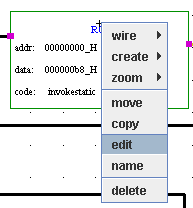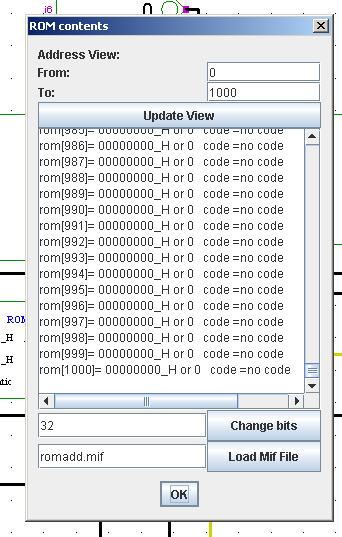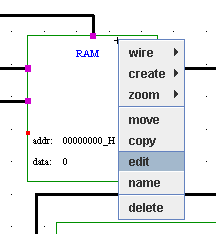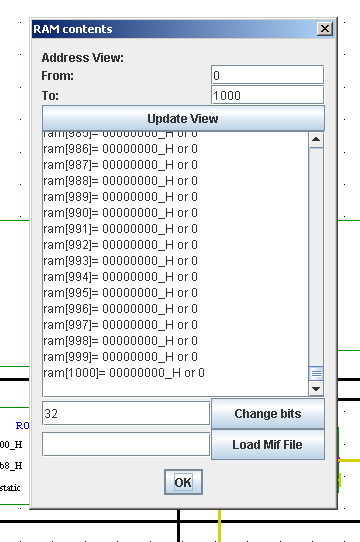

Applets
contents
visual index
 introduction
introduction std_logic_1164
std_logic_1164 gatelevel circuits
gatelevel circuits delay models
delay models flipflops
flipflops adders and arithm...
adders and arithm... counters
counters LFSR and selftest
LFSR and selftest memories
memories programmable logic
programmable logic state-machine editor
state-machine editor misc. demos
misc. demos I/O and displays
I/O and displays DCF-77 clock
DCF-77 clock relays (switch-le...
relays (switch-le... CMOS circuits (sw...
CMOS circuits (sw... RTLIB logic
RTLIB logic RTLIB registers
RTLIB registers Prima processor
Prima processor D*CORE
D*CORE MicroJava
MicroJava Pic16 cosimulation
Pic16 cosimulation Mips R3000 cosimu...
Mips R3000 cosimu... Intel MCS4 (i4004)
Intel MCS4 (i4004) image processing ...
image processing ... [Sch04] Codeumsetzer
[Sch04] Codeumsetzer [Sch04] Addierer
[Sch04] Addierer [Sch04] Flipflops
[Sch04] Flipflops [Sch04] Schaltwerke
[Sch04] Schaltwerke [Sch04] RALU, Min...
[Sch04] RALU, Min... [Fer05] State-Mac...
[Fer05] State-Mac... [Fer05] PIC16F84/...
[Fer05] PIC16F84/... [Fer05] Miscellan...
[Fer05] Miscellan... [Fer05] Femtojava
[Fer05] Femtojava
 adder
adder
 factorial
factorial
 calculator
calculator
 Multicycle F...
Multicycle F...
 Bubblesort
Bubblesort
 Insertion-sort
Insertion-sort
 Quicksort
Quicksort
 Pipelined Fe...
Pipelined Fe...
 quicksort (p...
quicksort (p... FreeTTS
FreeTTSPlease look at the following to learn more about FemtoJAVA pipeline [1], Sashimi Project [3] and CACO-PS [2] power estimation tool from Universidade Federal do Rio Grande do SUL (UFRGS), Brazil, head by Luigi Carro;
[1] CARRO, L. ; BECK FILHO, A C S . Low Power Java Processor for Embedded Applications. In: IFIP VLSI-SOC, 2003, Darmstadt. IFIP WG 105 Proceedings, 2003. p. 239-244. [2] BECK FILHO, Antonio Carlos ; MATTOS, Julio ; WAGNER, Flavio ; CARRO, L. . CACO PS - A General Purpose Cycle-accurate Configurable Power Simulator. In: 16th Symposium on Integrated Circuits and Systems Design, 2003, São Paulo. Proceedings. Los Alamitos : IEEE Computer Society Press, 2003. v. 1. p. 349-354. [3] ITO, S., CARRO, L., JACOBI, R. Sashimi and FemtoJava: making Java work for microcontroller applications. IEEE Design & Test of Computers. Estados Unidos: , p.100 - 110, 2001. This circuit was originally generated on CACO-PS Format (FJA FILE) [2]. CACO-PS is A General Purpose Cycle-accurate Configurable Power Simulator written on C, from UFRGS, Brazil. A FJA file is a structural format. Each component on CACO-PS has a C function to describe its behavior. A parser to converter FJA on HDS was written by Alisson Garcia and Ricardo Ferreira. Each C behavior description was encapsulated on Java file to generate a HADES component. This implementation is based on a microprogram at FSM unit (File instruction.fji). Please wait until the applet is fully loaded. Then use the popup-menu ('edit') on the ROM component to open the window with preferences. The default (romadd.mif) its a simple program based on the following code: int a,b,c; a = 5; b = 7; c = a + b;
 If you want to change the program, you can put these mif files in the box, then click on Load Mif file:
romSortBubble.mif -> Bubble Sort Code
romSortInsert.mif -> Sort Insert Code
romSortQuick.mif -> Quick Sort Code
romSortSelect.mif -> Select Sort Code
If you changed the default mif on the ROM, you will need to change the RAM component. Use the popup-menu ('edit') on the RAM component
to open the window with the preferences.
If you want to change the program, you can put these mif files in the box, then click on Load Mif file:
romSortBubble.mif -> Bubble Sort Code
romSortInsert.mif -> Sort Insert Code
romSortQuick.mif -> Quick Sort Code
romSortSelect.mif -> Select Sort Code
If you changed the default mif on the ROM, you will need to change the RAM component. Use the popup-menu ('edit') on the RAM component
to open the window with the preferences.

 ramSortBubble.mif -> If you choosed the Bubble Sort Code
ramSortInsert.mif -> If you choosed the Sort Insert Code
ramSortQuick.mif -> If you choosed the Quick Sort Code
ramSortSelect.mif -> If you choosed the Select Sort Code
These mif(RAM and ROM) files are generated using Sashimi Tool.
Now, you can start the simulation. If you want that the simulation runs automatic, just turn on the auto_clock, otherwise, you can control the clocks just clicking in manual_clock button.
ramSortBubble.mif -> If you choosed the Bubble Sort Code
ramSortInsert.mif -> If you choosed the Sort Insert Code
ramSortQuick.mif -> If you choosed the Quick Sort Code
ramSortSelect.mif -> If you choosed the Select Sort Code
These mif(RAM and ROM) files are generated using Sashimi Tool.
Now, you can start the simulation. If you want that the simulation runs automatic, just turn on the auto_clock, otherwise, you can control the clocks just clicking in manual_clock button.
 The processor finish the default code in 90 cicles.
Sort codes needs about 5800 cicles to finish.
The result can be found at the ram memory. For the default code, the result is placed at position 19. For the Sort codes, the vector generally start at position 20 (except for the ramQuickSort.mif).
The processor finish the default code in 90 cicles.
Sort codes needs about 5800 cicles to finish.
The result can be found at the ram memory. For the default code, the result is placed at position 19. For the Sort codes, the vector generally start at position 20 (except for the ramQuickSort.mif).